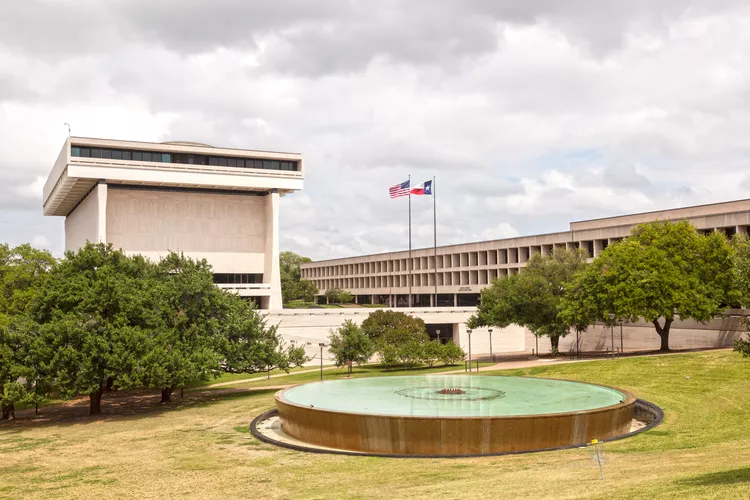2313 Red River St, Austin, TX 78705, USA
Phone +1 512-721-0200
Love him or hate him, President Lyndon Baines Johnson was one of the most fascinating characters in American history. He took over the presidency in the wake of the assassination of John F. Kennedy and pushed through a sweeping Civil Rights Act to honor Kennedy’s legacy. His Great Society initiative led to bills aimed at reducing poverty, supporting public broadcasting, improving healthcare, and protecting consumers. At the same time, however, he led the country deeper into the quagmire of the Vietnam War.
His presidential library on the eastern edge of the University of Texas campus seeks to tell the full LBJ story, warts and all.
History
Former President Johnson attended the opening ceremony for the library in 1971, but he visited only a few times before his death in 1973. The nondescript 10-story building looks more like a military facility than a library, with very few windows. The exterior walls are made of Italian travertine, which is similar in appearance to marble. A multimillion-dollar renovation was completed in 2012. Among the most popular additions were the listening stations, which allow visitors to hear LBJ in his own (often politically incorrect) words. The exhibit includes recorded phone conversations from the darkest days of the Vietnam War.
Things to See at the Library
Kennedy Assassination: This permanent exhibit covers the gut-wrenching period just after LBJ became president in the wake of Kennedy’s death. It features unforgettable photos of moments such as the swearing-in ceremony on Air Force One, with a distraught Jacqueline Kennedy looking over LBJ’s shoulder. Pick up the phone on the wall in this area to hear conversations from the era between LBJ and the former First Lady.
LBJ’s Presidential Limousine: This is the actual Lincoln Continental stretch limo used by LBJ in 1968, complete with a TV, car phone, and a backup gas tank for emergencies.
Civil Rights: You can read the text of speeches, view photos and watch videos about the Civil Rights Act in this area. LBJ wanted to promote civil rights, in part, as a way of continuing to pursue Kennedy’s agenda. The exhibit also includes the desk where LBJ signed the Voting Rights Act. This legislation has been in the news in recent years because the Supreme Court ruled that states formerly required to get preclearance before implementing changes to voting laws have been released from that requirement. This led several states to implement voter ID laws that critics say lead to lower voter turnout among minorities.
Social Justice Gallery: The Kennedy assassination and the Vietnam War often overshadow the other major events during LBJ’s presidency. His Great Society reforms were ambitious, including everything from anti-poverty programs to educational initiatives. The artifacts in this area bring LBJ’s deal-making abilities to life. He was an effective arm twister, back slapper, and occasionally a mean bully.
Oval Office Replica: This 7/8th-scale replica of the Oval Office in the White House is historically accurate down to the tiniest details, including the pens on the desk, the green multi-line phone, and the emblem on the ceiling. Kids enjoy looking at the bank of old-timey TVs next to the president’s desk.
How to Get There
The LBJ library is easy to spot from the I-35 freeway near the Martin Luther King Boulevard exit. The street address is 2313 Red River Street. Parking is free in the adjoining lot.
Tips for Visiting
Since the library is on the UT campus, crowds and traffic tend to be lighter when school is out of session. Check the online calendar while planning your visit. LBJ is one of the most well-studied presidents in history, and authors such as Robert Caro and Doris Kearns Goodwin occasionally speak and hold events at the library.
If you plan to explore the rest of the UT campus, make sure you wear comfortable shoes. The campus is still often referred to as “the 40 acres,” but it’s now much bigger than that, sprawling across more than 400 acres. If you wish to learn even more about Texas history, the Bob Bullock Texas State History Museum is just a couple miles down the road.
The Library is open daily 9 a.m. to 5 p.m. except for Thanksgiving, Christmas, and New Year’s Day. General admission is $10 for adults, $3 for kids 13 to 18.





